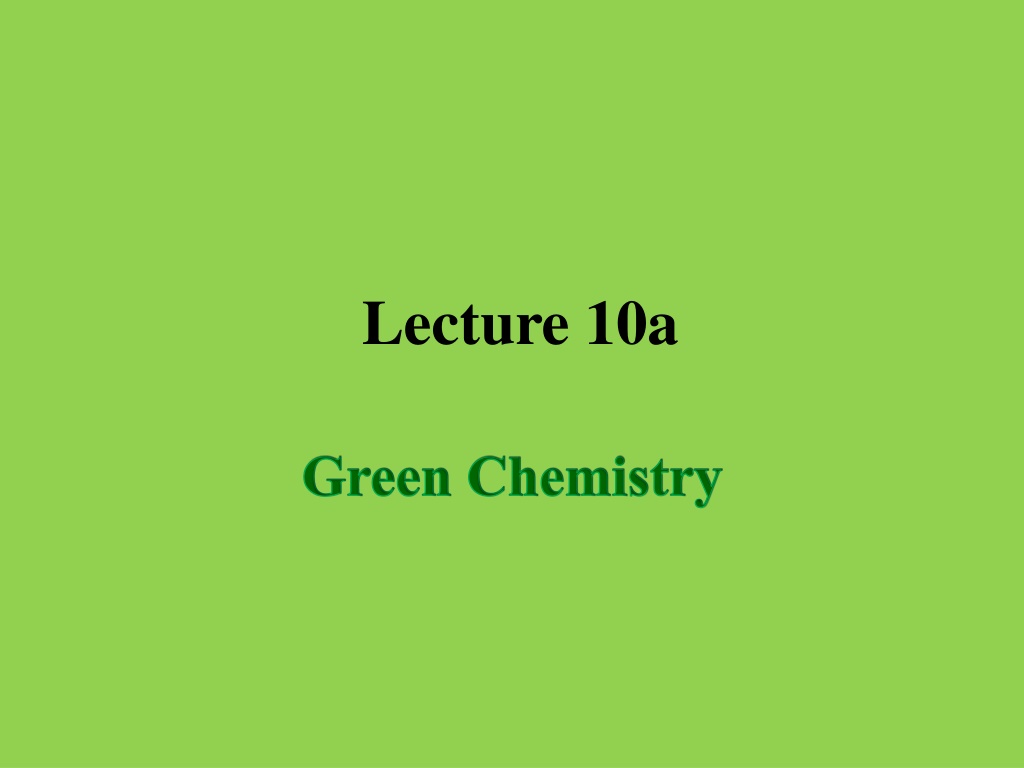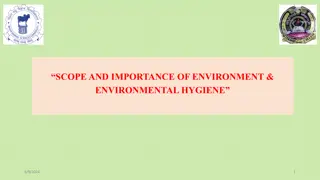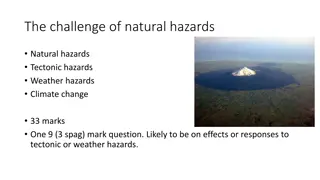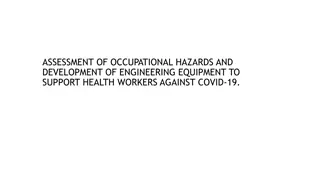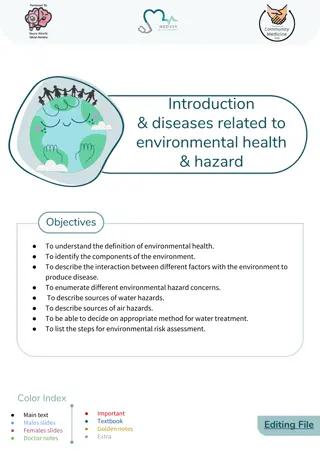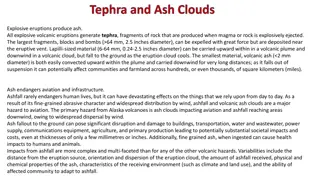Understanding Health Hazards in Chemical Production
Organic chemistry plays a vital role in producing various products, but it also poses serious health and environmental risks. Issues such as acute and chronic toxicity, carcinogens, mutagens, and teratogens are prevalent in chemical production. Awareness of these hazards has led to strict regulations governing waste management and emissions.
Download Presentation

Please find below an Image/Link to download the presentation.
The content on the website is provided AS IS for your information and personal use only. It may not be sold, licensed, or shared on other websites without obtaining consent from the author. Download presentation by click this link. If you encounter any issues during the download, it is possible that the publisher has removed the file from their server.
E N D
Presentation Transcript
Lecture 10a Green Chemistry
Introduction While organic chemistry is a very important part of everybody s life, the production of drugs, fuels, polymers, pigments, insect repellants, etc. also generates many problems due to the magnitude of the production today In the mid-19thcentury, organic dyes were produced and the waste products were vented into the atmosphere, dumped into rivers, lakes and landfills Due to the heavy contamination of the environment, many people were exposed to many hazardous compounds giving rise to countless illnesses (i.e., cholera, typhoid fever, emphysema, infant mortality) However, as the awareness for health and environmental impact of chemical production has grown, these methods of waste management have become very much unacceptable Today, waste management and any form of emission are heavily regulated on every level (local, state, federal and internationally)
Health Hazards I The famous Swiss-German scientist Paracelsus recognized during the early 16thcentury already that the same compound could be a remedy or a poison depending on the dose that was administered. Even some vitamins and common compounds (i.e., NSAIDs) display a significant degree of toxicity In general, each compound has to be assessed for its specific hazards (acute, chronic). The acute toxicity is often quantified by the LD50measure (the values in the table are for rats, oral). Compound Water Ethanol Sodium chloride Ibuprofen Vitamin D Aspirin Caffeine Nicotine Sodium cyanide Sarin (nerve gas) Botulinium toxin LD50(g/kg) 180 7.06 3.75 0.636 0.619 0.20 0.13 0.05 0.015 4*10-4 3*10-11
Health Hazards II Carcinogens and Suspect Carcinogens Carcinogen are compounds that are known to cause cancer in animals and/or humans. Benzo[a]pyrene, commonly found in cigarette smoke, charred meat and diesel exhausts, is well known to be a carcinogen. Aminonaphthalenes, benzidine and its derivatives, like asbestos, formaldehyde, benzene and vinyl chloride as well as several chlorinated ethers are also recognized carcinogens according to OSHA General Industry Standards. Other polycyclic aromatic hydrocarbons (PAH), their nitro (i.e., nitropyrene) and many nitroso compounds (R-NO) are considered suspect carcinogens because they possess chemical or structural similarities with known carcinogens. Many powerful alkylating agents i.e., methyl iodide, dimethyl sulfate, etc. are considered suspect carcinogens.
Health Hazards III Mutagens and Teratogens A reproductive toxins is defined as a chemical which affects the reproductive capabilities including chromosomal damage (mutations) and effects on fetuses (teratogenesis) . Many drugs have effects on the human reproductive system. Some may be desired effect like hormones and others have minor unwanted side effect (i.e., many antidepressants). Mutagens are compounds that cause mutations in the DNA. The DNA damage can cause cancer in humans, animals and bacteria. Representative mutagens are 2-aminopurine, 5-bromouracil and hydroxylamine. X-rays, gamma rays and alpha particles are considered physical mutagens. Teratogens are substances that cause developmental malformations (birth defects). The list contains many compounds ranging from inorganic compounds (i.e., cadmium, thallium, beryllium), organic solvents (i.e., benzene, chloroform, toluene, DMF), biological compounds (i.e., testosterone) and drugs (i.e., (R)- thalidomide). Currently, this list contains already more than 3100 compounds, among them caffeine, cholesterol, corn oil, hexane and toluene.
Health Hazards IV Lachrymators, Corrosives and Unstable Compounds Lachrymators are compounds that irritate the mucous membrane. Exposure to the vapors of these compounds leads to severe eye watering. Compounds like bromoacetone (was used as chemical weapon in WWI), benzyl bromide, benzyl chloride, thionyl chloride and syn-propanethial S-oxide (released from onions) belong to this class. Certain compounds are sensitive towards impact, heat or friction causing them to decompose explosively. Many peroxides and polynitrated compounds fall into this class (i.e., diethyl ether peroxide, acetone peroxide, benzoyl peroxide, nitroglycerin, trinitrotoluene, metal and organic azide, silver and mercury fulminate, nitrogen(III) halides). Corrosives are compounds that cause severe skin irritation and tissue damage upon contact. Strong acids and strong bases (i.e., concentrated sulfuric acid, concentrated sodium hydroxide solution) as well as compound that can form them belong into this group.
What are the Strategies used in Green Chemistry? The Pollution Prevention Act of 1990 emphasized the prevention of pollution at the source rather than the treatment of pollutants after they are formed and was more or less the start of the green chemistry initiative. Green chemistry aims to minimize risk by eliminating or reducing the use of hazardous substances. It involves inventing new methods to reduce chemical hazards while producing superior products in a more efficient and more economical way.
What is Green Chemistry? Anastas and Warner proposed The Twelve Principles of Green Chemistry in their book ( Green Chemistry: Theory and Practice , Oxford University Press, Oxford, UK, 1998): Prevention It is better to prevent waste than to treat or clean up waste after it has been created Atom Economy Synthetic methods should be designed to maximize the incorporation of all materials used in the process into the final product A.E=molecular mass of the desired product/molecular mass of all reactants * 100 % Less Hazardous Chemical Syntheses Wherever practicable, synthetic methods should be designed to use and generate substances that possess little or no toxicity to human health and the environment. Designing Safer Chemicals Chemical products should be designed to affect their desired function while minimizing their toxicity
What is Green Chemistry? Safer Solvents and Auxiliaries The use of auxiliary substances (i.e., solvents, separation agents, etc.) should be made unnecessary wherever possible and innocuous when used Design for Energy Efficiency Energy requirements of chemical processes should be recognized for their environmental and economic impacts and should be minimized. If possible, synthetic methods should be conducted at ambient temperature and pressure. Use of Renewable Feedstocks A raw material or feedstock should be renewable rather than depleting whenever technically and economically practicable Reduce Derivatives Unnecessary derivatization (use of blocking groups, protection/ deprotection, temporary modification of physical/chemical processes) should be minimized or be avoided if possible, because such steps require additional reagents and can generate waste.
What is Green Chemistry? Catalysis Catalytic reagents (as selective as possible) are superior to stoichiometric reagents. Design for Degradation Chemical products should be designed so that at the end of their function they break down into innocuous degradation products and do not persist in the environment. Real-time analysis for Pollution Prevention Analytical methodologies need to be further developed to allow for real-time, in-process monitoring and control prior to the formation of hazardous substances. Inherently Safer Chemistry for Accident Prevention Substances and the form of a substance used in a chemical process should be chosen to minimize the potential for chemical accidents, including releases, explosions, and fires.
Solvents I Solvents appear to be necessary for many reactions to occur but their presence also causes many problems i.e., they reduce the reactivity of many reagents and starting materials They limit the lower and upper temperature at which the reaction can take place, which can have advantages and disadvantages Solvents are also used in the workup and purification process (i.e., extraction, recrystallization, chromatography, etc.). The problem is that many of the commonly used solvents are volatile. Thus, the experimenter and the environment can be exposed to them.
Solvents II Hydrocarbons Hydrocarbons (i.e., alkanes like hexane, petroleum ether; aromatics like toluene) are volatile, which poses a substantial inhalation risk. They tend to affect primarily the central nervous system (CNS) and can cause lung damage. Toluene is a reproductive toxin. They are also flammable and represent a significant fire hazard as well. Halogenated Hydrocarbons Halogenated hydrocarbons i.e., dichloromethane, chloroform display relatively low boiling points and are very volatile. The experimenter can be exposed to the liquid and the vapors potentially leading to problems with the central nervous system, kidneys, liver and heart. Many of them are considered suspect carcinogens, mutagens and/or teratogens. Alcohols Many alcohols are commonly used in the lab (i.e., methanol, ethanol, iso-propanol) They are flammable and some of them are toxic (i.e., methanol). In addition, extended exposure to their vapors can also lead to health problems.
Solvents III Ethers Like alcohols, ethers (i.e., diethyl ether, tetrahydrofuran) are frequently used solvents in organic synthesis (i.e., Grignard reaction, Diels-Alder reaction). Their volatility makes them a fire hazard. In addition, they tend to form explosive peroxide upon extended exposure to air and light. Dipolar Solvents Ketones are generally low in toxicity but they are volatile and pose a fire hazard. Acetonitrile is toxic in higher concentrations, while DMF can impair liver and kidney function. Dimethylsulfoxide enhances skin absorption of solutes and can cause dermatitis and liver dysfunction on chronic exposure. Nitrobenzene is very toxic and is also readily absorbed through the skin. Hexamethylphosphoramide (HMPA) is a very toxic and a known carcinogen.
Solvents IV The combination of toxicity and volatility makes many of these solvents hazardous. While the best approach is to use no solvent in the reaction, this is unfortunately not possible in most reactions according to current knowledge. Ethanol and isopropanol are generally good choices because they are relatively nontoxic. Benzene is often replaced by toluene or xylene because they are less volatile and appear to be a little bit less hazardous (yet not healthy either) Chlorinated solvents are difficult to replace because of their unique ability to dissolve many compounds. In some cases, a solvent mixture of an ester and a hydrocarbon can be used. Ethers sometimes can be replaced by esters (i.e., ethyl acetate, other acetates, phthalates), which are less volatile. In addition to these solvents, water, supercritical solvents (i.e., carbon dioxide) or ionic liquids (i.e., N-dodecylpyridinium chloride or 1-ethyl-3-methylimidazolium acetate) can be used in some reaction. Solvents like 2-methyltetrahydrofuran (obtained by acid-catalyzed digestion of sugars followed by hydrogenation) and cyclopentylmethyl ether have garnered a lot of interest.
Solvents IV New Generation of Solvents Name Structure mp (oC) bp (oC) Flash Point (oC) Vapor Pressure at 20 oC (mmHg) Propylene carbonate -55 242 135 0.03 -Valerolactone -31 207 81 N-methyl-2- pyrrolidinone (NMP) -24 202 91 0.29 1,3-dimethyl-3,4,5,6- tetrahydro-2(1H)- pyrimidinone (DMPU) -20 14646 120 low Ethyl lactate -25 154 46 1.7 Diacetone alcohol -44 172 58 0.95
Reagents I Alternative reagents have to be milder than the old reagents but reactive enough to perform the chemical transformation with comparable or superior efficiency and selectivity The formation of byproducts should be minimized reducing the need for separation and purification steps. The use of protective groups has to be reduced to minimize waste and to increase atom economy, which is defined as the ratio of the mass of the product over the mass of all reactants. If all atoms from the reactants are incorporated in the product, the atom economy is 100 % (i.e., addition of bromine to double bonds, hydrogenation reactions) Most common reactions (i.e., Fischer esterification, elimination, oxidation, Wittig reactions) are far from close this ideal case The atom economy will decrease significantly if protective groups or chiral auxiliaries are used in the reaction.
Reagents II The alternative reagent should display a low volatility, a low flammability and low toxicity. The environmental impact of the alternative reagent should be low. In some cases, electrosynthesis, photochemistry, biological reagents, biocatalysis (enzymes or coenzymes) or catalysis in general can serve as alternative methods as well. Parameters like recovery, reuse (recycling) and regeneration have to be considered when designing a new reaction ( Three R s of green chemistry ). Recovery refers to the isolation of solvents and spent reagents after the reaction was completed A more effective the recovery simplifies the recycling and the regeneration process (i.e., catalyst) Ultimately, the atom economy of the reaction should be as high as possible to reduce the need for recovery, recycling and regeneration The perfect chemical reaction is completely selective, highly efficient, safe, and does not require solvent or any energy input.
Starting Materials Traditionally, many starting materials are derived from coal or petroleum. These are nonrenewable resources and their extraction brings its own set of problems (i.e., environmental, health problems, dependability from OPEC). As a result, the trend has been going towards a biomass-based feedstock. For instance, ethanol and biodiesel are obtained from corn and soybeans. Glycerol is a byproduct in the biodiesel production, which is converted to propylene glycol by catalytic hydrogenation. Many compounds in the chiral pool can be isolated from the biomass (i.e., amino acids, hydroxy acids (tartaric acid), carbohydrates, terpenes ( -pinene), alkaloids). The dehydration of fructose leads to the formation of hydroxymethylfurfural (HMF), which can be further hydrolyzed to form levulinic acid (LA) and formic acid. Levulinic acid can be used to form methyltetrahydrofuran, -valerolactone, etc.
Energy Sources While the ideal reaction does require any energy input, this is not the case with most reactions in the lab. Heat is frequently needed to increase the rate of the reaction or the solubility of the reagents in the reaction medium. The cheapest source of energy is the sun but it is often challenging to harvest this energy efficiently. However, the sunlight is sometimes used in photochemical reactions (i.e., reduction of benzophenone to form benzopinacol, formation of Fe2(CO)9from Fe(CO)5). Other than using the conventional heating methods (i.e., hotplate with Al-block, heating mantles, water bath, oil baths), the reaction mixture can also be heated using a microwave Microwave reactions are often solvent-free or employ a high-boiling solvent (i.e., DMSO, propylene glycol, etc.) In rare cases, grinding the reaction mixture produces enough heat to promote the reaction (Grindstone Chemistry)
Lab Example I Synthesis of Benzopinacol Conventionally obtained from benzophenone by reduction with metals like magnesium Greener synthesis uses sunlight and isopropanol
Lab Example II Synthesis of Phenytoin Conventionally, the reaction requires an extended reflux in a solvent like ethanol or DMSO Greener synthesis uses microwave in solid state reaction without a solvent
Lab Example III Synthesis of Chalcones ( -unsaturated ketones) Obtained by Claisen-Schmidt reaction (Aldol-reaction), a reaction of a ketone with an aldehyde often using a base as catalyst (i.e., KOH, K2CO3, K3PO4, etc.) The reaction is traditionally carried out in solution (i.e., ethanol), requires heating and long reaction times in some cases. An greener method uses grindstone chemistry (mortar) or a microwave reaction, both without solvent for the reaction
Synthesis of Ibuprofen I The Boots Company of England (now BASF) developed the original synthesis of ibuprofen in the 1960 s. It involved a six-step process that generated millions of pounds of unwanted waste. This process became known as a Brown process because many of the reactants in the process are not incorporated into the product resulting in poor atom utilization (~40 %).
Synthesis of Ibuprofen II In 1991, BHC Company (Boots-Hoechst-Celanese, 1997 Presidential Green Chemistry Challenge Winners) developed a greener synthesis, which only required three steps. This process incorporated most of the reactants (77 % without recycling, 99 % with recycling) into the final product, reducing or eliminating most of the waste byproducts. Hydrofluoric acid, Raney nickel and palladium metal can be recovered and reused.
Simvastatin I Prof. Yi Tang (UCLA) and Codexis won the 2012 Greener Synthetic Pathways Award for An Efficient Biocatalytic Process to Manufacture Simvastatin Simvastatin (also known as Zocor), a leading drug for treating high cholesterol, is manufactured from a natural product. The traditional multistep synthesis was wasteful and used large amounts of hazardous reagents. In the new route, lovastatin is hydrolyzed and converted to the water-soluble ammonium salt of monacolin J. Then, a genetically evolved variant of LovD acyltransferase from E coli. uses DMB-SMMP as the acyl donor to make the water-insoluble ammonium salt of simvastatin. The only coproduct of simvastatin synthesis is methyl 3-mercapto-propionic acid, which is recycled. The final yield of simvastatin ammonium salt is over 97 %. The new route avoids the use of several hazardous chemicals including tert-butyl dimethyl silane chloride, methyl iodide, and n-butyl lithium.
Biosynthesis of Alcohols The 2010 Presidential Green Chemistry Challenge Winners was awarded to James C. Liao (UCLA) and Easel Biotechnologies for the Recycling Carbon Dioxide to Biosynthesize Higher Alcohols They developed a microbial technology to produce alcohols with 3 8 carbon atoms from CO2. The technology leverages the highly active amino acid biosynthetic pathway, diverting its 2-keto acid intermediates toward alcohols. With this technology, isobutanol can be produced from glucose in near-theoretical yields with high efficiency and specificity. The method also transferred the pathway into a photosynthetic microorganism, Synechococcus elongatus PCC7942, which produces isobutyraldehyde and isobutanol directly from CO2. The engineered strain produces isobutanol at a higher rate than those reported for ethanol, hydrogen, or lipid production by cyanobacteria or algae.
Isobutanol Usage Feedstock in the manufacture of isobutyl acetate, which is used in the production of lacquer and similar coatings, and in the food industry as a flavoring agent Precursor of derivative esters - isobutyl esters such as diisobutyl phthalate (DIBP) are used as plasticizers in plastics, rubbers, and other dispersions Precursor of p-xylene, a building block for plastic bottles, textiles and clothing. Paint solvent Varnish remover Ink ingredient Paint additive, to reduce viscosity, improve brush flow, and retard formation of oil residues (blush) on painted surfaces Gasoline additive, to reduce carburetor icing Automotive polish additive Automotive paint cleaner additive Chemical extractant in production of organic compounds Mobile phase in thin layer chromatography Potential gasoline alternative
Summary and Outlook Ultimately, green chemistry is chiefly about sustainability. Scientists need to find ways of reducing the negative human impact on the environment by developing more environmentally friendly chemical engineering, by using a more responsible management of environmental resources and by considering environmental protection in any process more while maintaining the quality of life that we are accustomed to today. While in many cases there are already alternatives, they are economically not always feasible/competitive because of their cost (i.e., solar energy, biodiesel). The environmental impact (I=P*A*T) will increase because of the world population (P) keeps growing together with the level of the individual consumption (A=affluence) and the impact per unit of resource use (T). Plenty of work to do for future generations of scientists!
Is this the END? For many of you, this will be the last organic chemistry lecture. For some of you, it was just the beginning of a lot more organic chemistry. In either way, the instructor hopes that you will take some of value with you from this course. If so, it would be nice to indicate this in the evaluation.
